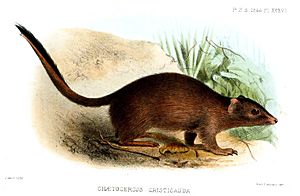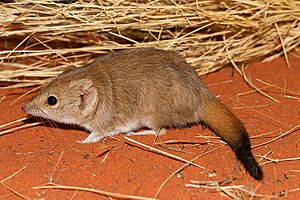Mulgara facts for kids
Quick facts for kids Mulgaras |
|
|---|---|
 |
|
| Crest-tailed mulgara (Dasycercus cristicauda) | |
| Scientific classification |
|
| Kingdom: | Animalia |
| Phylum: | Chordata |
| Class: | Mammalia |
| Infraclass: | Marsupialia |
| Order: | Dasyuromorphia |
| Family: | Dasyuridae |
| Subfamily: | Dasyurinae |
| Tribe: | Dasyurini |
| Genus: | Dasycercus Peters, 1875 |
| Type species | |
| 'Chaetocercus' cristicauda Krefft, 1867
|
|
| Species | |
Mulgaras are two types of small, furry animals. They are marsupials, which means they carry their babies in a pouch. Mulgaras are also carnivores, so they eat other animals. They are related to the Tasmanian devil and quolls.
These animals live in the hot, dry deserts of Australia. You can find them in areas with spinifex grasslands. Mulgaras are mostly active at night, but sometimes they "sunbathe" near their burrows. Their bodies are amazing at saving water. Their kidneys make super concentrated pee, so they almost never need to drink! They mostly eat insects, but also enjoy small reptiles and mammals. Mulgaras usually have babies between June and September. Their pouch is made of two skin folds on their sides.
Scientists used to be confused about mulgara types. Now we know there are two main species. The brush-tailed mulgara (D. blythi) has a tail without a crest. It also has two upper premolar teeth and six nipples. The crest-tailed mulgara (D. cristicauda) has a cool crest of hair on its tail. It has three upper premolar teeth and eight nipples. The name Dasycercus means "hairy tail."
Contents
Meet the Mulgara Species
It was once hard to tell the two mulgara species apart. But now, thanks to detailed studies, we can identify them better. The easiest way to tell them apart is by looking at their tails.
Crest-tailed Mulgara
The crest-tailed mulgara has a crest of long, black hairs. This crest is on the top of the end of its tail. This species is also known as the Ampurta. It is listed as vulnerable, meaning it needs protection.
Brush-tailed Mulgara
The brush-tailed mulgara has a brush of black hairs. This brush runs along the last two-thirds of its tail.
Other Differences
The two species also have slight differences in their teeth. However, this is hard to see in live animals. The brush-tailed mulgara has six nipples. The crest-tailed mulgara has eight nipples. Both types of mulgaras live in short burrows in Australia's dry regions.
How Mulgaras Save Energy: Torpor
Both mulgara species use something called torpor every day. Torpor is like a mini-hibernation. It helps them save energy. They use torpor both in the wild and when studied in labs.
Torpor and Reproduction
Unlike many other mammals, mulgaras use more torpor when they are pregnant. By saving energy with torpor, pregnant females can gain more body weight. This extra weight helps them store fat for feeding their babies later. Both pregnant females and breeding males use torpor during the winter. However, wild males only use torpor for a short time during the breeding season. They use it more often after the breeding season is over.
See also
 In Spanish: Dasycercus para niños
In Spanish: Dasycercus para niños


